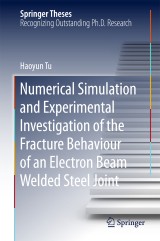Details

Numerical Simulation and Experimental Investigation of the Fracture Behaviour of an Electron Beam Welded Steel Joint
Springer Theses
|
CHF 118.00 |
|
| Verlag: | Springer |
| Format: | |
| Veröffentl.: | 12.10.2017 |
| ISBN/EAN: | 9783319672779 |
| Sprache: | englisch |
Dieses eBook enthält ein Wasserzeichen.
Beschreibungen
<div>In this thesis, the author investigates experimentally and numerically</div><div>the fracture behavior of an electron beam welded joint made from</div><div>two butt S355 plates. The 2D Rousselier model, the Gurson-Tvergaard-</div><div>Needleman (GTN) model and the cohesive zone model (CZM) were</div><div>adopted to predict the crack propagation of thick compact tension (CT)</div><div>specimens. Advantages and disadvantages of the three mentioned models</div><div>are discussed. The cohesive zone model is suggested as it is easy to use</div><div>for scientists & engineers because the CZM has less model parameters</div><div>and can be used to simulate arbitrary crack propagation. The results</div><div>shown in this thesis help to evaluate the fracture behavior of a metallic</div><div>material. A 3D optical deformation measurement system (ARAMIS) and</div>the synchrotron radiation-computed laminography (SRCL) technique<div>reveal for the first time the damage evolution on the surfaceof the sample</div><div>and inside a thin sheet specimen obtained from steel S355. Damage</div><div>evolution by void initiation, growth and coalescence are visualized in</div><div>2D and 3D laminographic images. Two fracture types, i.e., a flat crack</div><div>propagation originated from void initiation, growth and coalescence</div><div>and a shear coalescence mechanism are visualized in 2D and 3D images</div><div>of laminographic data, showing the complexity of real fracture. In</div><div>the dissertation, the 3D Rousselier model is applied for the first time</div><div>successfully to predict different microcrack shapes before shear cracks</div><div>arise by defining the finite elements in front of the initial notch with</div><div>inhomogeneous f0-values. The influence of the distribution of inclusions</div><div>on the fracture shape is also discussed. For the analyzed material, a</div><div>homogeneous distribution of particles in the material provides the</div><div>highest resistance to fracture.</div><p></p>
Introduction.- Scientific background.- Characterization of steel S355 electron beam welded (EBW) joints.- The Rousselier model.- The Gurson-Tvergaard-Needleman (GTN) model.- The Cohesive zone model.- Optical measurement of crack propagation with the ARAMIS system.- In situ laminography investigation of damage evolution in S355 base material.- Summary and Outlook.
<p>Haoyun Tu is an Assistant Professor at the School of Aerospace Engineering and Applied Mechanics, Tongji University, PR China. He received his BE and ME from Northwestern Polytechnical University, China and Dr.-Ing. from University of Stuttgart, Germany. His research interests are on fracture mechanism of metals and welded joints from metals with experimental and finite element methods as well as on characterization techniques such as 3D optical deformation measurement and Synchrotron radiation-computed laminography (SRCL).</p>
<div>In this thesis, the author investigates experimentally and numerically</div><div>the fracture behavior of an electron beam welded joint made from</div><div>two butt S355 plates. The 2D Rousselier model, the Gurson-Tvergaard-</div><div>Needleman (GTN) model and the cohesive zone model (CZM) were</div><div>adopted to predict the crack propagation of thick compact tension (CT)</div><div>specimens. Advantages and disadvantages of the three mentioned models</div><div>are discussed. The cohesive zone model is suggested as it is easy to use</div><div>for scientists & engineers because the CZM has less model parameters</div><div>and can be used to simulate arbitrary crack propagation. The results</div><div>shown in this thesis help to evaluate the fracture behavior of a metallic</div><div>material. A 3D optical deformation measurement system (ARAMIS) and</div>the synchrotron radiation-computed laminography (SRCL) technique<div>reveal for the first time the damage evolution on the surfaceof the sample</div><div>and inside a thin sheet specimen obtained from steel S355. Damage</div><div>evolution by void initiation, growth and coalescence are visualized in</div><div>2D and 3D laminographic images. Two fracture types, i.e., a flat crack</div><div>propagation originated from void initiation, growth and coalescence</div><div>and a shear coalescence mechanism are visualized in 2D and 3D images</div><div>of laminographic data, showing the complexity of real fracture. In</div><div>the dissertation, the 3D Rousselier model is applied for the first time</div><div>successfully to predict different microcrack shapes before shear cracks</div><div>arise by defining the finite elements in front of the initial notch with</div><div>inhomogeneous f0-values. The influence of the distribution of inclusions</div><div>on the fracture shape is also discussed. For the analyzed material, a</div><div>homogeneous distribution of particles in the material provides the</div><div>highest resistance to fracture.</div>
Suggests cohesive zone model as the ideal for the prediction of crack propagation Concludes essential infomation for the evaluation of the fracture behaviour of metallic materials Reveals the nature of the fracture mechanism of an electron beam welded joint Includes supplementary material: sn.pub/extras
Suggests cohesive zone model as the ideal for the prediction of crack propagation<div>Concludes essential infomation for the evaluation of the fracture behaviour of metallic materials</div><div>Reveals the nature of the fracture mechanism of an electron beam welded joint</div><div><br/></div>
Diese Produkte könnten Sie auch interessieren:

Neutron Applications in Earth, Energy and Environmental Sciences

von: Liyuan Liang, Romano Rinaldi, Helmut Schober

CHF 177.00

Nanobioelectronics - for Electronics, Biology, and Medicine

von: Andreas Offenhäusser, Ross Rinaldi

CHF 118.00














